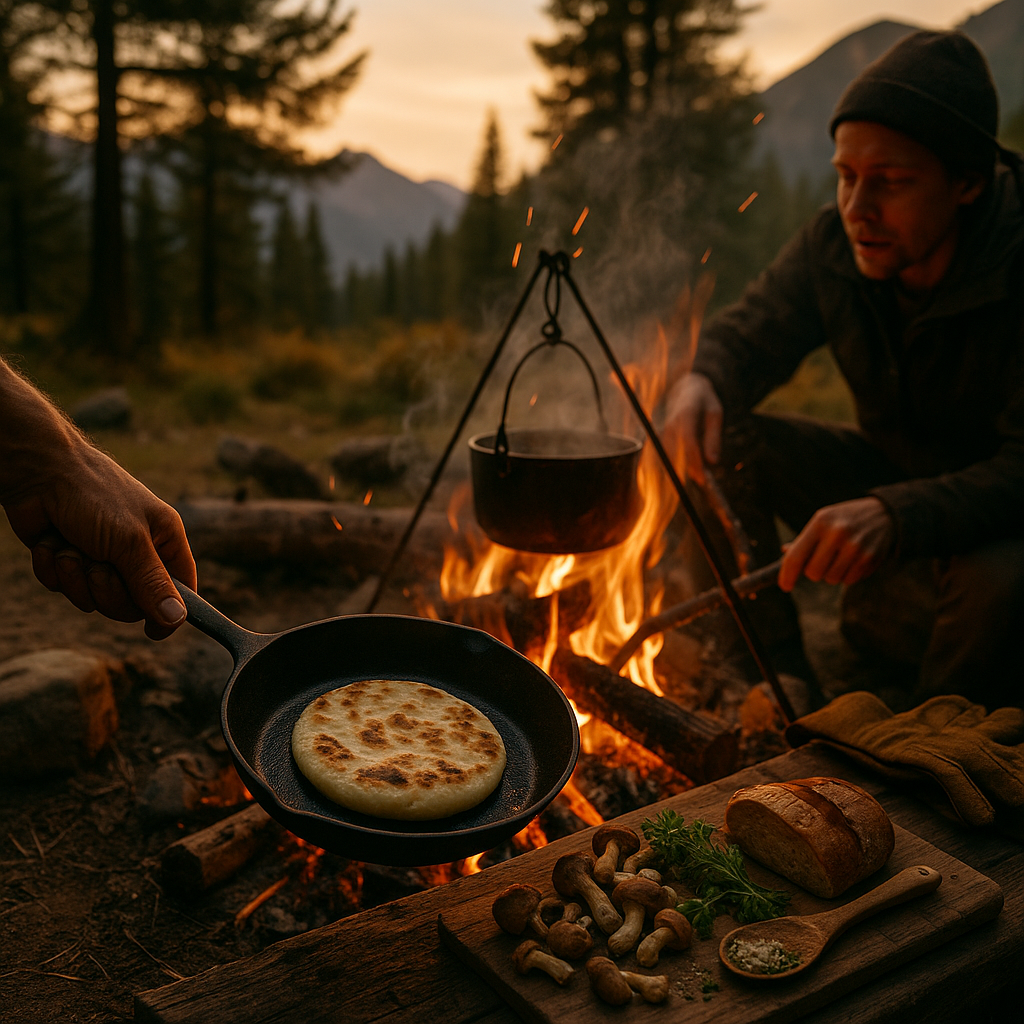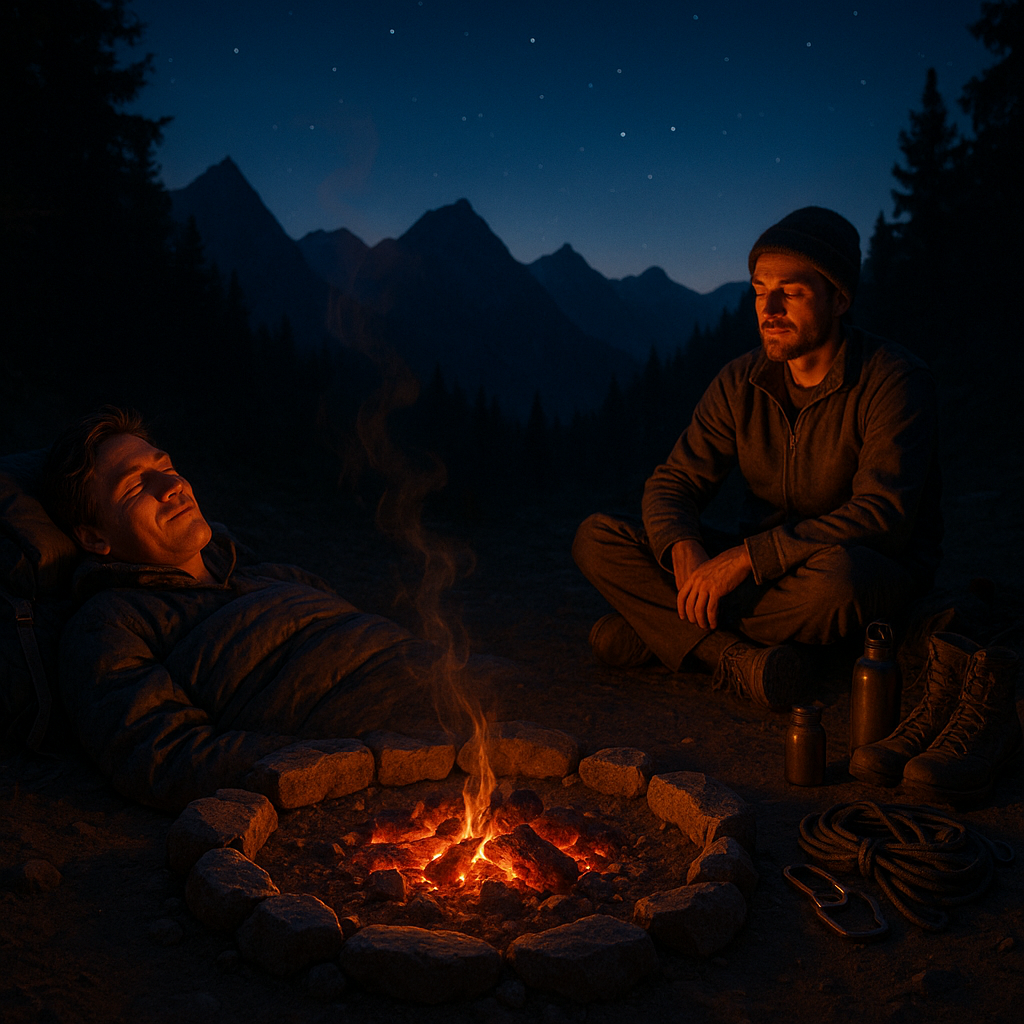Key Takeaways
- Savoring discomfort elevates the meal. Cooking and eating in the wild tests resilience: icy wind bites, wood smoke stings, and rough textures remind you that deliciousness and discomfort are intertwined, making every bite richer and more memorable.
- Hand-fed fire cooking deepens connection. Sharing food hand-to-mouth around the fire strips away formalities, fostering an intimacy between cook, eater, and the surrounding landscape. This ancient ritual forges bonds that linger long after the flames have faded.
- Nature itself seasons the meal. Each flame-cooked dish soaks in the scent of the forest, the grit of the wind, and the warmth of glowing embers, imprinting every flavor with the wildness of the environment.
- Every meal becomes a memory, not just a dish. The minor aches (the sting of heat, the ache of hunger, the chill of open air) etch themselves into your story, making food and landscape inseparable in recall.
- Fire forges emotional resilience and gratitude. Enduring the elements and sharing food by the flames cultivates gratitude for simple sustenance, transforming discomfort into a celebration of what it means to be alive and free.
- Rituals of pain and fire ground us in authenticity. These raw, unscripted meals let you shed digital noise and perfectionism, reminding you that beauty thrives in imperfection, hunger, and togetherness.
Embarking on a pain and fire meal is a rite of passage for both palate and spirit. As we explore this wild tradition, you’ll discover sensory stories, bold flavors, and landscapes where pain and pleasure are inseparable companions around the campfire.
Introduction
The taste of wild food is sharpened by the world itself: hands cracked by cold, smoke stinging your eyes, and mouths fed straight from smoldering wood. In these pain and fire meals, eating becomes a primal celebration where deliciousness blends inseparably with discomfort, and every bite is alive with wind, wood, and the honest ache of hunger.
These wild rituals transcend any mere test of endurance. Mealtime here becomes memory—a tapestry woven with embers, shared vulnerability, and the hush of open sky. Step into the heart of the pain and fire meal, where raw landscapes season every dish and the joy of being truly alive is not just tasted, but deeply shared and savored.
The Origins and Spirit of Pain and Fire Meals
Throughout human history, food and fire have been inseparable companions. In the flicker of a wilderness flame lies a profound truth: discomfort often shapes our sweetest flavors. Pain and fire meals aren’t simply about cooking outdoors or embracing rustic aesthetics; rather, they represent a conscious departure from convenience, a return to the elemental, where the struggle of creation is as important as the result.
Stay Sharp. Stay Ahead.
Join our Telegram Channel for exclusive content, real insights,
engage with us and other members and get access to
insider updates, early news and top insights.
 Join the Channel
Join the Channel
Ancient cultures across the world recognized this connection. Mongolian nomads shared feasts on endless steppes, savoring what the land and fire provided. Indigenous Australians marked sacred times by coming together for dreamtime ceremonies, where flames united communities and food became a channel for story and memory. In the far north, Sámi herders gathered around communal fires, letting hardship and nature season their stews and smoked fish.
Today, as we revive hand-fed flame cooking, we purposefully set aside the push-button ease of modern kitchens. The physical challenges (smoke-stung eyes, heat-reddened hands, patience tested by shifting weather) reconnect us with food’s true value. Every hard-won bite becomes a symbol of our willingness to embrace both struggle and satisfaction.
The Sensory Landscape
Engaging in wilderness cooking awakens dormant senses. The aroma of pine and hardwood threads through the air, infusing every dish with notes no urban kitchen can replicate. The distinct crackle and pop of burning twigs announce a lively fire; the metallic tang of cast iron blends with earth and ash, creating flavors rooted in place and moment.
Cooking with fire is inherently intuitive. You learn to interpret the subtle language of glowing coals, knowing that the heart of the embers burns hotter than the gray edges. Wind, far from being a mere obstacle, becomes both disruptor and collaborator—sometimes stoking flames to their peak, sometimes testing your resolve and creativity.
This physical engagement transforms cooking into a dynamic dance between human and environment. Stoking and tending the fire is an act of presence, and feeding companions by hand is a gesture that carries as much meaning as the meal itself.
Weather’s Influence on Taste
Understanding the wilderness kitchen means embracing weather’s unpredictable hand. Bitter winter winds sharpen your taste for salt and umami, making broths more comforting and bread more satisfying. Humid summer evenings intensify smoky notes, conjuring flavors that linger long after sunset. Rain forces improvisation, leading to unexpected combinations and a sense of shared accomplishment. Even altitude subtly alters both cooking times and taste sensitivity, challenging experienced camp cooks and newcomers alike to adapt their methods.
Beyond the culinary world, similar patterns of adaptation shape experiences in diverse fields. In healthcare, outdoor nutrition programs use environmental factors to enrich recovery and resilience. Adventure educators harness weather’s unpredictability to foster growth and teamwork. In sustainable tourism, chefs and guides deliberately use local conditions to craft immersive, place-based experiences.
The Communion of Hand-Fed Flame Cooking
Sharing food around a fire reconnects us with rituals far older than formal dining. There is an intimacy in feeding someone: removed from utensils and tableware, you open up space for trust and vulnerability. In the wild, this moment is magnified. Faces ringed by firelight, hands passing morsels from flame to mouth, participants shed layers of social pretense.
The challenges of the wild (smoke-watered eyes, chapped knuckles, the precision needed to offer another a perfectly charred bite) turn mealtime into a shared act of courage. Conversation flows deeper. Laughter becomes more genuine. The pauses between stories are filled not by awkwardness, but by the rhythmic crackle and glow of burning wood.
This primal communion resonates beyond culinary circles. In therapeutic settings, outdoor group meals forge bonds capable of lasting far beyond the trip. Education programs leverage fire circles to encourage honest reflection and peer-to-peer learning. Even in business retreats, stripping back barriers with elemental meals can cultivate interpersonal trust and creative problem-solving.
Pain, Resilience, and Transformation
Within each pain and fire meal lies the opportunity for transformation. Smoke in your eyes becomes part of the anticipation. Burned fingers, small wounds, and failures are catalysts for learning patience and adapting swiftly. The discomforts of the wild (whether failing to light a damp fire in the rain or improvising with scarce ingredients) teach flexibility and grit.
These lessons spill into life beyond the campfire. Just as a chef learns from each failed loaf or charred potato, anyone who faces discomfort head-on develops a new respect for resilience. Participants consistently report feeling changed: more willing to endure adversity, slower to seek shortcuts, and quick to celebrate small victories.
The symbolism of fire, used to turn raw food into nourishment, has inspired not only outdoor enthusiasts but also those in fields as diverse as psychology, environmental education, and leadership training. The metaphor of keeping a flame alive through hardship resonates powerfully with the challenges of modern work and life.
Crafting Your Own Experience
Before undertaking your own pain and fire meal, start with thoughtful preparation. The right tools make a profound difference:
Essential Tools
- A well-seasoned carbon steel or cast iron pan, capable of withstanding open flames
- Long-handled tongs, spatulas, and forks for safety and control
- Heavy-duty leather gloves to protect against heat and splinters
- Natural fire starters (birch bark, fatwood, or dried grass)
- Sturdy, weather-resistant kindling and fuel for consistent heat
Mindset Preparation
Equally crucial is your mental approach:
- Embrace imperfection; perfection is the least interesting ingredient in any recipe
- Double your usual cooking time to account for unpredictability
- Expect and accept failure; it is an essential seasoning for growth
- Choose simple, elemental dishes that allow the fire’s personality to shine
Start small: flame-roasted vegetables, charred flatbreads, or a single-skillet hash. As your comfort and skill grow, experiment with whole fish, slow-cooked stews, or even baking in embers. Mastery comes not from recipes, but from a deepening relationship with fire and place.
Stay Sharp. Stay Ahead.
Join our Telegram Channel for exclusive content, real insights,
engage with us and other members and get access to
insider updates, early news and top insights.
 Join the Channel
Join the Channel
Just as sustainable architects adapt their designs to local terrain, and expeditionary educators tailor methods to group strengths, so too must wild cooks calibrate their craft to nature’s moods.
Making the Memory
The true heart of the pain and fire meal experience is found in the memories it forges. Every sense participates: the snap of glowing wood, the warmth against your cheeks, the taste of earth and sky mingled in every bite.
Capturing these moments is itself an act of reverence. Photography around a fire rewards patience. Wait for the twilight’s golden hour, let flames silhouette faces, or capture close-ups of sooty hands breaking bread. Journaling, meanwhile, should be immediate and honest. Notes on weather, flavors, laughter, and silence bring back each meal’s unique character.
fire diary practice is an excellent way to document each unique meal, preserving the evolution of skills and the sensory details that might otherwise be forgotten.
Creating Lasting Impact
- Document the evolution of your skills and recipes, capturing both successes and failures
- Record the stories, jokes, and reflections shared in firelight; these are as nourishing as the meal itself
- Immerse your photography in the broader scene. Show both food and context, hands, faces, sky, and earth
- Collect mementos: pressed leaves, sketches, scraps of annotated map (small reminders of where story met sustenance)
These personal archives aren’t just for nostalgia. They inspire further journeys, connect us to others who share our yearning for authenticity, and remind us that some of life’s richest flavors are reserved for those who endure and embrace a little wildness.
Conclusion
Pain and fire meals call us to rediscover the beauty that hides within discomfort, forging connections not only to the natural world but also to one another and to ourselves. The unseen spices (smoke-tinged patience, hands toughened by flame) transform simple sustenance into a multisensory rite of passage.
As we gather under open sky, trust and shared struggle dissolve old boundaries, forging new stories under the ancient language of firelight. These elemental meals, immortalized in memory and journal, challenge us to find the richest flavors where nature’s unpredictability meets our willingness to lean in.
Looking ahead, the movement toward elemental, experience-centered cooking is poised to shape not only food culture but broader approaches in wellness, education, leadership, and adventure travel. Those who are willing to seek out raw experience (who accept the challenges of wind, weather, and wild place) will cultivate not just resilience, but a deep gratitude for life’s authentic moments. In the end, pain and fire meals promise a singular truth: the next great adventure, and the deepest savoring of your journey, waits where discomfort becomes the doorway to wonder.
wood flavor profiles can add yet another dimension to your wild meals, making each fire an opportunity for discovery. And if you wish to embrace transition and adaptability in your cooking, explore the nuances of threshold season meals—where shifting elements become part of the feast itself.





Leave a Reply